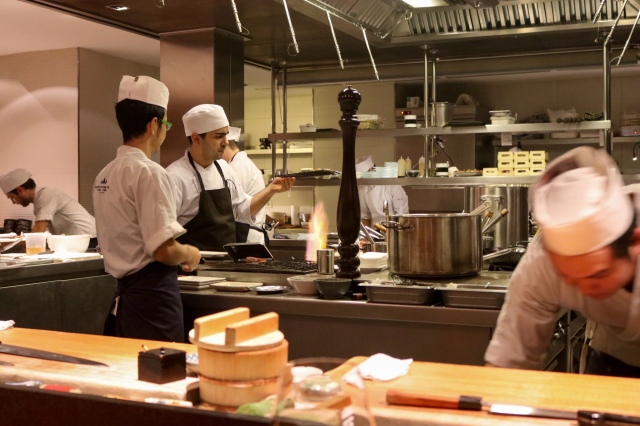
cc-AT Joan
The Great British Menu is back on UK television at the moment. I am not a fan of cooking programmes – though others are in my household – so, it’s on and inevitably I get caught up in it. Assessment is the central device in these reality programmes, creating tension and the reward.
I am struck by the assessment model on The Great British Menu. Three cooks work together over four days vying to create the best dish for each of four courses. The kitchen is a supportive space, characterised by a degree of banter and mutual respect. Although the cooks are in competition, they are professional and co-operative in attitude. They will discuss amongst themselves what they are each doing and how well they are managing. As they ready their work for presentation and tasting each will support the others, as needed, to plate the food. You wonder that there is never any thought of sabotage – co-operation (not collaboration) overcomes competition in this kitchen. As fellow professionals, they give and take criticism as a constructive opportunity to review their work.
They are judged each day by a respected chef who provides each of them with detailed feedback and awards points, thereby identifying the winner of that round. In arriving at a judgement, the chief chef and each competitor chef will go off to analyse the work. The chief will ask the competitor, “How satisfied are you with what you have done? Why?” The chief asks, ” What Mark would you give yourself for this then?”There is no point in the competitor overblowing their work; the situation demands an honest and justified self-appraisal. You sense that if the competitor did over-estimate their work they would be penalised for not having the capability to make a fair estimation I.e. it would be a sign that they isn’t know what ‘good’ food looked like. The competitor returns to the kitchen and the chief chef makes some notes and comes up with a mark.
Meanwhile, the remaining two cooks are discussing the dish prepared by their fellow competitor. They know to be respectful – after all they don’t want the others to treat their work disrespectfully while they’re being judged. They also give their peer a mark.
As each competitor chef returns to the kitchen they ask “How did it go?” And so forth. They’ll often reveal their own thoughts on the dish, and the mark they awarded. As a viewer you are never sure, at the end of the day, whether the peer assessment is taken into consideration or not, but the important thing here is that, b assessing each other’s cooking, the chefs demonstrate how they are learning from each other and they reveal much about their own knowledge and critical capabilities.
On the fifth day each chef has taken on board the feedback they have received from the chief chef (their mentor) and from their peers and applied this to improve their respective dishes.
The programme’s format changes at the end of the series when the best dishes from the best chefs are selected to form the menu at a prestigious gala event. This is the motivational prize that creates the ultimate conceit for the show.
There’s a lot to be learnt here in terms of good teaching practices in general, but particularly in relation to studio-based learning.
The kitchen is a vibrant and authentic learning environment – there is action and integrated feedback everywhere you look as the chefs work meticulously through a range of processes to execute their ideas by applying their skills. You here them mutter frustration when they make silly, self-defeating mistakes and you see the creative flow when they are working skilfully and at pace. You see them continually stretch themselves to excel, to the extent that sometimes they are clearly over ambitious. While occasionally they fail, you wonder at what there aspired to achieve and what they have learnt about themselves in the process.the cooks are always critically reflecting on their work, usually managing a high degree of useful objectivity. Their self-assessment, often being overly critical on themselves, is so typical of what we know about self-assessment in education. It is also clear that the value of this is not about the actual marks they award themselves, but how you learn through self-evaluation.
The co-operative nature of peer assessment is well-modelled. This is about creating a professional learning environment of mutual respect. The need to award a mark is a device to make the peers conclude through making a critical decision. In all cases, assessment in this studio environment is fair and supported by evidence. It is criterion-based too, although we never see a rubric. The criteria are in the shows narrative: taste, texture, interpretation of the task, creativity, organisation, and so forth.
All of these ingredients reflect an ideal student-centred learning environment, but looking at Shaffer’s (2007) framework for the studio as a coherent system, the open social space of the kitchen and its equipment equate to the surface structures of a studio, the design, execution and assessment methods employed by the cooks equates to the pedagogical activities, and the deployment of skills and knowledge about cuisine equate to the epistemology.

I found your blog through DS106. How could adding some photos to some of the paragraphs to demonstrate your points help? Could you also add an image of Shaffer’s framework? I like your break down of the participant’s collaboration and communication styles.